|
Samburu National Reserve, Kenya July 2000 |
||
| (Click any photo throughout to see a larger version) | ||
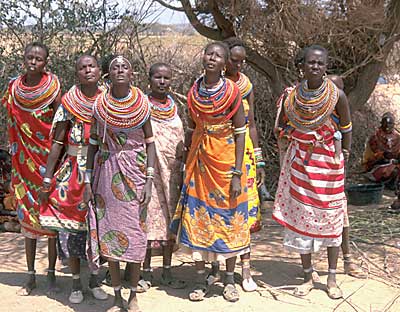
|
||
| Song of the Samburu | ||
| We stayed a few days in the Samburu National Reserve, more northerly than anywhere else we stayed in Kenya. We visited a "traditional" (authentic in style but somewhat commercialized in behavior) Samburu village where the women greeted us in song. The Samburu tribespeople are closely related to the more well-known Masai, whom we visited later at the Masai Mara Game Reserve. Each tribe has mostly kind words to say about the other, while emphasizing that they of course are the more beautiful. | ||
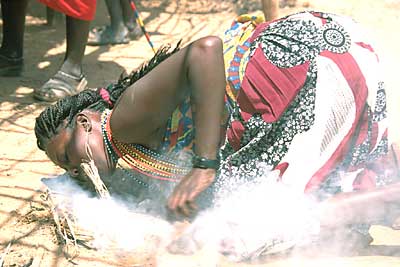
|
||
| Smoke of the Samburu | ||
| This Samburu woman is finishing the process of starting a fire, after a pair of Samburu warriors started it with a lot of stick-rubbing. Though most Samburu probably use matches nowadays, it was still impressive to see how quickly and effectively they could start a fire from scratch. | ||
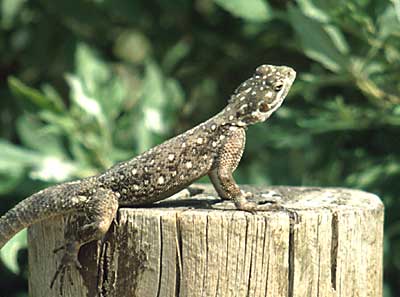
|
||
| Lounge Lizard | ||
|
We stayed for two nights at the Samburu Intrepids tented camp inside the Samburu National Reserve.
It was built right next to the Samburu river, with most buildings up on wooden platforms in
case of flood. However, the drought Kenya had been experiencing for several years meant that
not only were the tents in no danger of washing away, but the river bed was in no danger of
containing any water at all at this point.
Perhaps to make up for this lack of natural water, the camp included a traditional hotel-style swimming pool. This large common agama and a bunch of its buddies were hanging out poolside. Having a pool at a tented camp seems wrong to me, but having large groups of lizards at the pool makes it OK in my book. | ||
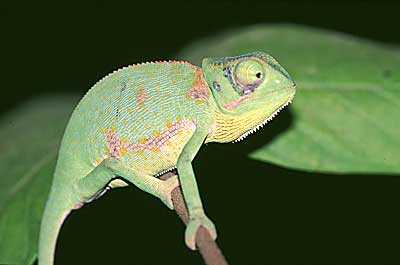
|
||
| Budweiser Jokes Prohibited | ||
| In addition to the poolside agamas, Samburu Intrepids tented camp also featured cute little day geckos, charming nocturnal geckos, and at least this one chameleon. Most of the visitors would sleep or hang out in the pool or bar while at the camp, while I would poke around the grounds looking for interesting lizards. I didn't find this one, though; it was discovered by armed members of the camp staff, who were willing to show it to me but were fearful for my well-being as I approached to take pictures. Chameleons, bizarre-looking creatures that they are, tend to inspire a lot of extreme reactions. | ||
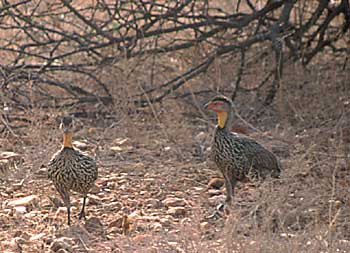
|
||
| Almost Flightless | ||
| Moving on to the feathered reptiles department, I loved these yellow-necked spurfowl, which vastly preferred a quick waddle to any sort of flight. I thought of them as the penguins of the savanna; humorous and clumsy in appearance, but well-equipped for their particular niche. They were quite common throughout our entire trip, in both Uganda and Kenya. | ||
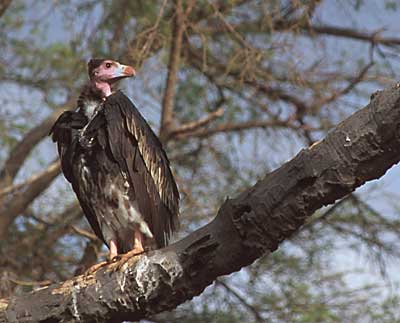
|
||
| Now That's a Vulture | ||
| Since I'm not any good at taking pictures of small, flighty birds, I tried to take a decent number of pictures of large, sedate birds so my bird-watching friends wouldn't disown me entirely. Fortunately there are many such birds in East Africa. This one is a white-headed vulture, probably a juvenile based on the brightness of the head colors. | ||
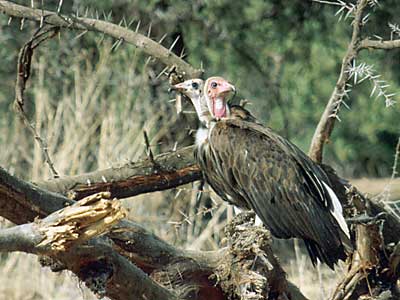
|
||
| Two Heads Are Better Than One | ||
| Africa has more types of vultures than you can shake a stick at. Here's a pair of hooded vultures. White-face is a juvenile, pink-face an adult. Don't go shaking sticks at them though. They look pretty mean. | ||
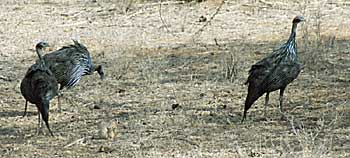
|
||
| Not Another Type of Vulture | ||
| These bizarre birds are not ground vultures but rather vulturine guinea fowl. They're not even very closely related to vultures. They sure have the vulture-shaped heads though. Perhaps they used to look like ordinary guinea fowl, and somebody shook a stick at them. (OK, OK, I promise no more lame jokes about shaking sticks. Lord knows what even got me started on that.) | ||
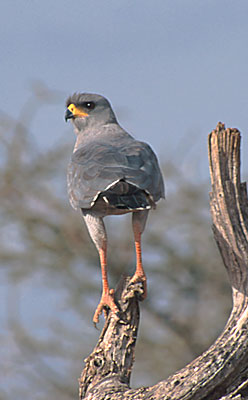
|
||
| Goshawk | ||
| To fill out the avian department on this page, here's an Eastern pale chanting goshawk. Tragically, none of the several such birds we encountered blessed us with song. | ||
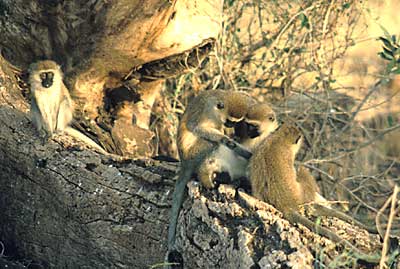
|
||
| Wallflower | ||
| Here's a troop of vervet monkeys grooming in the early morning light. The little one on the left looks like it didn't get invited. Vervet monkeys were very common throughout Kenya. | ||
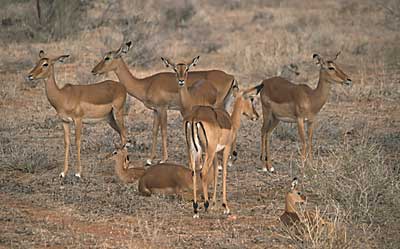
|
||
| Impala Moms and Youngsters | ||
| These are female Impala with a few babies. Adult males are equipped with horns. Thanks to Nancy Rosner for correcting my original misidentification; I had them listed as Grant's Gazelles, but the adult females in that species have small horns, whereas adult female Impala have none. | ||
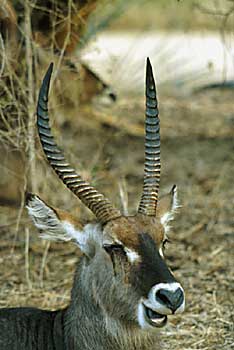
|
||
| Raconteur | ||
| This adult male waterbuck seems content with life. I think of him as an engaging joke teller: "A zebra, a giraffe, and a hippo met in a bar..." | ||
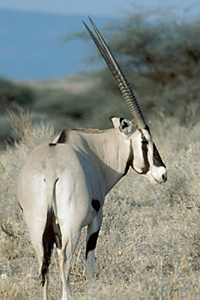
|
||
| Two Horns Are Better Than One | ||
| Oryx are vaguely horselike and have two beautiful long sharp horns that from the side can appear as one, as this one was almost willing to demonstrate for my camera. Some people think that oryx were the source of unicorn legends. | ||
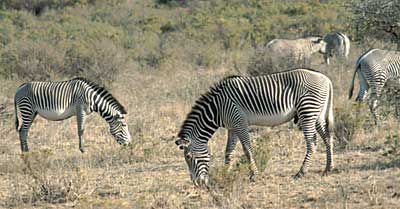
|
||
| Grevy's Zebra | ||
| Samburu had many different types of large mammals than the ones in the other, more southerly, parks we visited. For instance, at other parks we saw common zebra, but at Samburu we saw Grevy's zebra like these. Grevy's zebra have much finer stripes and white bellies, and are 73% more beautiful than standard zebra. | ||
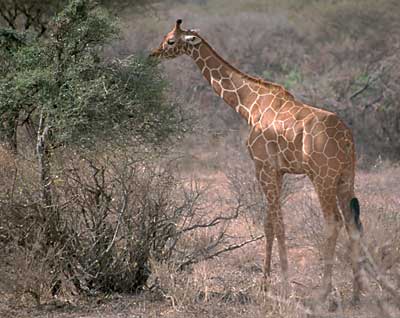
|
||
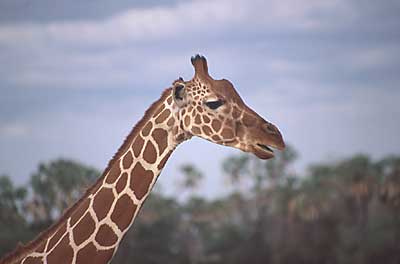
|
||
| Reticulated Giraffe | ||
| The giraffe in Samburu were a different type also. Elsewhere we saw common or Masai giraffe, but Samburu giraffe were reticulated giraffe, like these two. Once again, the Samburu species was voted the more beautiful by ten out of every twelve tourists. | ||
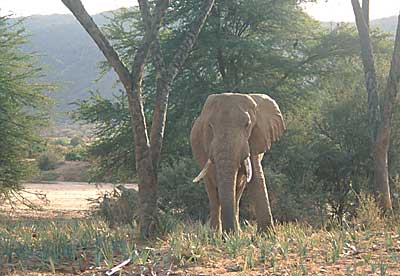
|
||
| Harvesting Nuts | ||
| This elephant was snacking on doum palm nuts. We twice saw it reach up with its trunk to grab a branch of the palm (the tree with forked branches to the left of the elephant in this picture), then shake vigorously for a few seconds. This sent a cascade of nuts to the ground, from which the elephant would then pick and choose its favorites. | ||
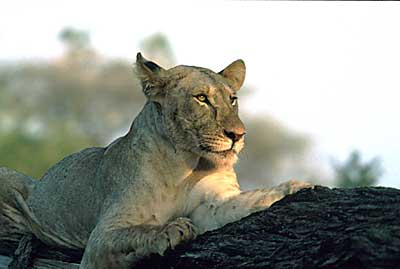
|
||
| Resting, As Usual | ||
| We ended up seeing many lions in both Uganda and Kenya, perhaps forty or so. The majority of them were napping, preparing to nap, or taking a very brief break from napping. Just like our evil housecat Thumper, lions seem to base their days around their napping schedules. This one was part of a pride that had recently taken down a young giraffe and scared away a leopard that was interested in the dead giraffe, so perhaps it was especially tired. | ||
Onward to Lake Nakuru and Lake Elmenteita | ||
| Return to Uganda and Kenya Trip Overview | ||